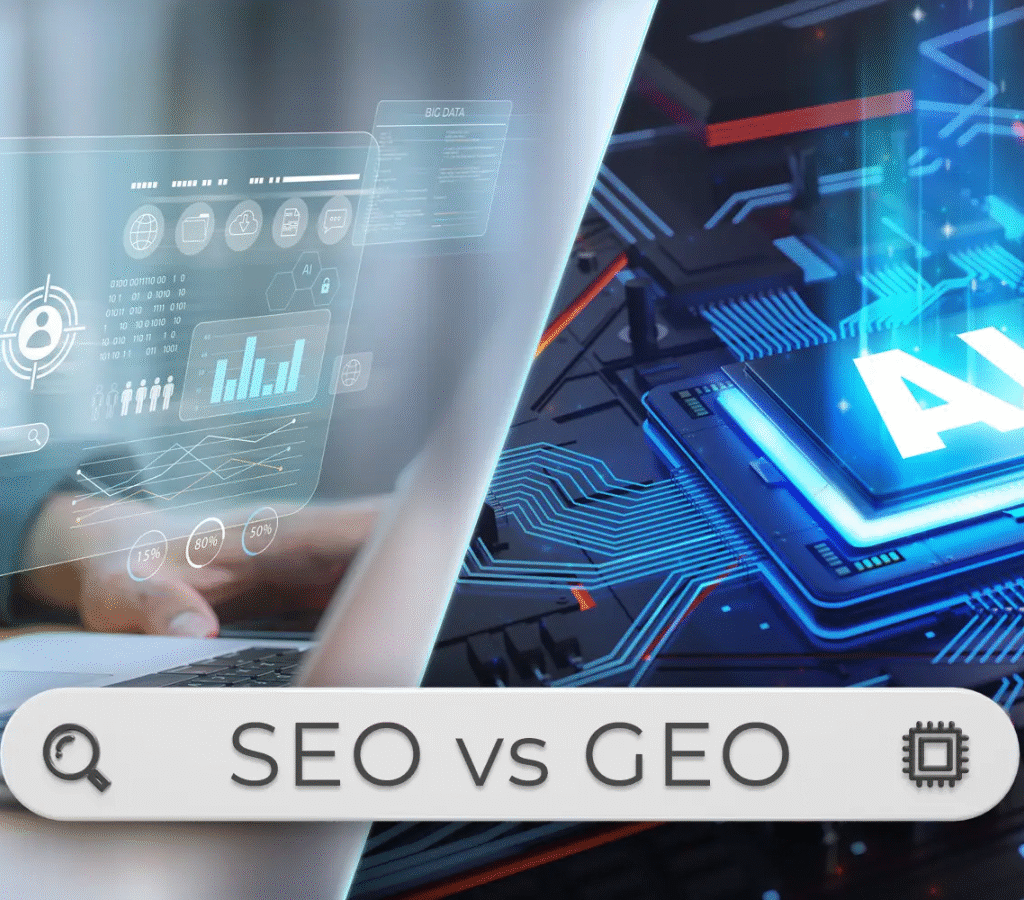Search is evolving faster than ever. For years, businesses have poured time, money, and creativity into SEO (Search Engine Optimization) and it still works wonders. But now, a new player has entered the game: GEO (Generative Engine Optimization).
With AI tools like ChatGPT, Google’s AI Overviews, and Gemini giving people direct answers, the way we search and consume information is shifting. Instead of clicking on multiple websites, users now get bite-sized, ready-made summaries from AI itself.
And that leaves business owners wondering:
“Do I still focus on SEO? Or should I start investing in GEO?”
Let’s break it all down in simple, clear terms, so you can make the smartest marketing moves for 2025.
What is SEO (Search Engine Optimization)?

SEO is the art (and science) of getting your website to appear higher on Google’s search results.
Think of it like raising your hand in a classroom and saying to the teacher (Google):
“Hey, I know the answer—send the question to me!”
SEO includes strategies like:
- Using the right keywords so Google matches your page to what people search.
- Improving your website speed and structure so it’s easy to use.
- Writing blogs, guides, and landing pages that people (and Google) find valuable.
- Building backlinks—like references from other trusted sites that boost your credibility.
In short: SEO gets people to click on your link from Google.
For example, if someone searches “best marketing agency in New York,” a strong SEO strategy helps your agency pop up in those results bringing actual visitors to your site.
What is GEO (Generative Engine Optimization)?
Now here’s the twist. GEO is about teaching AI-driven engines like ChatGPT or Google’s AI Overviews to include your brand in their answers.
In the past, if someone searched “Best CRM tools for startups,” they’d browse 10–15 different sites. Now, they might just read ChatGPT’s or Google’s AI-generated summary.
If your brand isn’t in that summary, you don’t exist in that searcher’s world.
GEO is built on:
- Clear, direct answers that AI can easily understand.
- Structured content with headings, lists, and data points.
- FAQs and how-to guides that solve real user problems.
- Expert insights and case studies that show authority.
In short: GEO gets your brand mentioned inside AI’s answers even if the user never clicks a website.
Think of GEO like whispering your brand’s name to the AI so it remembers to bring you up in conversations.
SEO vs GEO: What’s the Difference?

It’s not about SEO versus GEO, it’s about where visibility comes from.
- SEO = People click on your website.
- GEO = People see your brand inside AI-generated responses.
Both increase visibility, but in different ways.
Let’s compare:
| Feature | SEO (Search Engine Optimization) | GEO (Generative Engine Optimization) |
|---|---|---|
| Audience behavior | Users search and click results | Users read instant AI-generated summaries |
| Main goal | Drive traffic to your website | Get brand mentions in AI answers |
| Content style | Long-form, keyword-rich blogs & pages | Concise, structured, FAQ-style answers |
| Impact | Higher web traffic, conversions | Increased brand visibility & trust |
Why GEO Matters in 2025
Here’s why ignoring GEO could cost businesses big time:
- Gen Z prefers AI search.
More than 65% of Gen Z say they go to AI tools first instead of Google for quick answers. - Google’s AI Overviews dominate.
In many searches, AI Overviews sit above traditional results—stealing attention before users scroll. - Fewer people are clicking websites.
By 2025, up to 30% of searches may never reach traditional websites.
That means even if your SEO is solid, your traffic might shrink if you’re not also visible in AI-generated responses.
Imagine running a shop in a mall but refusing to list your store on the mall directory. Shoppers walk past without noticing. That’s what ignoring GEO feels like in the AI-first world.
Do You Need SEO or GEO?
The truth: you need both.
- If you’re a local business or online store → SEO is still your bread and butter.
Someone searching “best pizza near me” still clicks on Google Maps and local sites. - If you’re a SaaS, service provider, or thought leader → GEO gives you an edge.
When people ask AI tools questions like “best productivity app” or “how to build a brand on LinkedIn,” you want your brand in that AI-generated summary. - If you want to future-proof → blend SEO + GEO.
This way, you’ll capture traffic from Google AND visibility from AI.
How to Blend SEO + GEO (Without Overcomplicating)
Here’s the best part: you don’t need a completely new strategy.
You just need to make your current SEO more GEO-friendly.
Stick to SEO Basics:
- Mobile-friendly, fast-loading site.
- Keyword-rich but natural content.
- Consistent blogs, guides, and resources.
- Link-building for authority.
Add GEO-Friendly Tactics:
- Write FAQs that answer questions in one to two sentences.
- Use bullet points and structured lists (AI loves easy-to-skim data).
- Add stats, case studies, and original insights.
- Create short, clear summaries under subheadings.
Track Both Worlds:
- SEO → check keyword rankings, impressions, and clicks.
- GEO → check brand mentions, citations, and AI-generated visibility.
Pro tip: If you notice customers saying “I saw your name on ChatGPT,” that’s GEO at work.
Real-World Example
Imagine you run a fitness coaching business.
- With SEO: You write a blog titled “10 Best Workouts for Busy Professionals”. If optimized well, it ranks on Google, and users click your link.
- With GEO: You include FAQs like “What’s the quickest workout for office workers?” and clear bullet points. Now, when someone asks ChatGPT or Gemini, your blog might be summarized and your brand name included.
That’s the power of doing both.
FAQ’s
Q1: Is GEO replacing SEO?
No. GEO is not replacing SEO—it’s enhancing it. SEO drives clicks. GEO drives mentions. You need both for full visibility.
Q2: What kind of content works best for GEO?
Content that’s short, direct, and structured: FAQs, how-tos, expert insights, and stats.
Q3: Can I do SEO and GEO at the same time?
Yes, and you should. Start with SEO as your foundation, then layer GEO-friendly strategies into your blogs and guides.
Q4: Does GEO matter for small businesses?
Yes. Even small businesses can appear in AI search results when optimized properly. For example, a local bakery answering “What’s the best gluten-free cake in [city]?” could show up in AI responses.
Q5: How do I measure GEO results?
Unlike SEO clicks, GEO success shows in citations, mentions in AI results, customer feedback, and increased brand trust.
Q6: Which should I invest in more?
It depends on your business. If you’re eCommerce or local—lean SEO. If you’re in SaaS, education, or B2B services—lean GEO. But ideally, balance both.
Final Thoughts
SEO has built the internet as we know it. But in 2025, GEO is reshaping how people find and trust brands.
The smartest businesses won’t choose between the two. They’ll combine SEO’s proven power with GEO’s rising influence ensuring they’re visible everywhere their customers search, whether that’s on Google, ChatGPT, or Gemini.
At Chasegeek Digital, we’re already helping businesses prepare for this future. From ranking on Google to being cited in AI-generated responses, we make sure your brand is present, visible, and trusted across all search platforms.
In 2025, don’t just chase clicks. Chase visibility. The future belongs to brands that master both SEO and GEO.

Leave a Comment